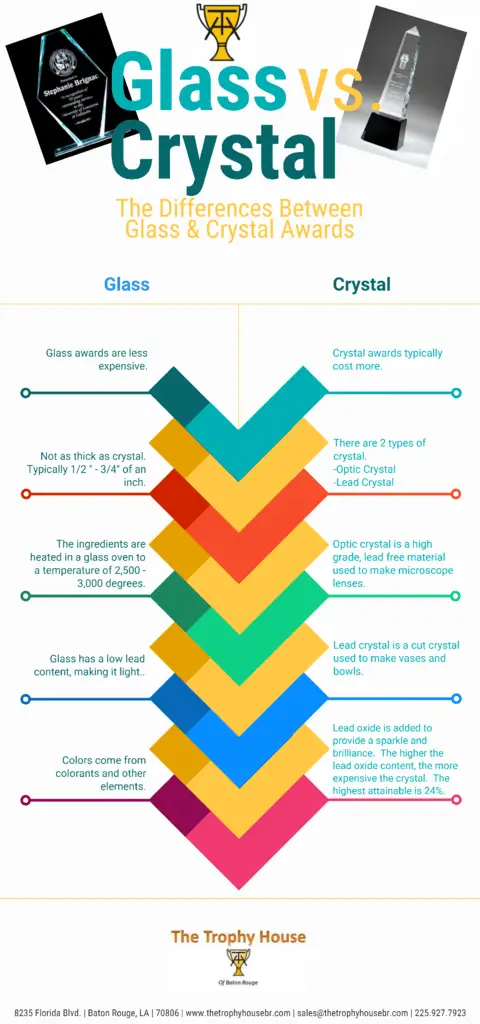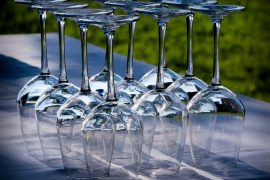How to tell the difference between glass and crystal
What is the difference between crystal and glass?.
A: The answer is “c.” Crystal has a lead content of at least 24 percent whereas glass has no lead.
Generic terms: The tumblers stored in most people’s kitchen cupboards are referred to as the “everyday” glassware. These items have a sturdy, almost indestructible quality that helps them withstand hundreds of dishwashings and plummetings from counters and tables. The glassware reserved for finer use-goblets with etched designs and pencil-thin stems, for example-often is called crystal. But is it really crystal?
Crystal is actually a kind of glass that is appreciated due to its fine details as well as its refraction and clarity. Glass, on the flip side, is a bit “rougher”. It can be tricky to tell them apart at a glance for a regular person. If you are thinking about buying an expensive set of glassware, however, it wouldn’t hurt to know the differences between these two to make a good purchase.
Crystal
- Refracts light (e.g. sparkly)
- more durable; rim can be made very thin
- Is porous and usually not dishwasher safe
- lead and lead-free options
- Expensive ($$$)

Glass
- Typically more affordable ($)
- Is non-porous and dishwasher safe
- Borosilicate glass provides high-end durable glass option
Benefits of Glass
There are a great many types of glass, so suffice it to say that this article breezes over the basics. That said, the primary benefit of glass is that it’s non-porous and inert, meaning that it will not absorb chemical aromas or corrode if you wash it in your dishwasher.
Most glass wine glasses will have a lip at the rim for durability which is not a desirable feature for wine enjoyment. This is why glass wine glasses tend to be made and sold more cheaply. There is, however, one type of glass with some great potential and that’s borosilicate glass. It has high durability, heat and scratch resistance–if you’re familiar with bodum coffee glass mugs, these are also made with borosilicate.
Benefits of Crystal
Crystal is a bit of a misleading term, it should actually be called lead glass (or mineral glass) because it does not have a crystalline structure. The benefits of crystal is its ability to be spun thin. This is useful specifically for wine glasses at the rim/edge of the glass where it can be very thin, but still quite strong.
Lead glass also refracts light, which is quite desirable when ogling your wine. There is another type of crystal that will excite people with dishwashers called lead-free crystal. It’s usually made with magnesium and zinc. Lead-free crystal is not only durable, but many are dishwasher safe. Not that I’d ever put one in my dishwasher, but restaurants do, so you can too!
Lead vs Lead-free Crystal
As far as quality, both types of crystal –lead and lead-free, –can be crafted into very fine glasses. Traditionally, all crystal glass was leaded glass and many of it still is. It’s not dangerous as a glass because wine is not exposed to the glassware long enough to leach lead. This only happens in long term storage, for example if you were to store whisky for over a week in a crystal whisky decanter.
Not All Crystal is Made Equal
In the UK, a glass product must contain at least 24% mineral content. The percentage of mineral matters and will affect the strength of the crystal. In the US, however, there is little regulation associated with the term crystal glass and manufacturers may misuse the term.
Which is Better?
When choosing wine glasses, the best way to start is to think about your personal situation.
- If you hate hand-washing things, look for lead-free crystal or standard glass
- If you break things frequently, go for glass and keep on partying.
- If you want the have the “best”, get hand-spun crystal
- If you love your mom, buy her crystal too.
For example, if you have kids or cats, then you might want to opt for an affordable glassware solution or stemless glasses that are less likely to get knocked over. That said, if you can have just 1 or 2 special crystal glasses for occasional wine appreciation, they make a big difference in the tasting experience, even if it’s just a feeling.
Crystal often is used as a generic term for any glassware that has a form more elegant than the glassware or jelly jars used every day. Nevertheless, it is not always an accurate label.
Maintaining standards: According to John Kennedy, head of technical services at Waterford in Waterford, Ireland, there are very specific guidelines for what constitutes real crystal. Kennedy notes the three primary criteria for crystal: a lead content in excess of 24 percent, a density in excess of 2.90 and a reflective index of 1.545.
These specifications were established in 1969 by the European Union, the main trading block of 15 European countries. The United States, Kennedy says, never established its own criteria, but accepts the European standard for customs purposes.
Getting the lead out: According to Kennedy, the key ingredient in crystal is lead. Waterford crystal traditionally has a lead content of about 32 percent. Although some finer glassware may contain lead, anything below the 24 percent standard is not considered crystal. Common glassware contains about 50 percent silica (sand), but no lead.
Is it real? Distinguishing real crystal from crystal wannabes can be difficult. According to Kennedy, only an expert can detect real crystal by sight. Nevertheless, there are a few distinguishing characteristics that help in detecting the real thing. Because of the high lead content, crystal rings when tapped ever so gently and is heavier than common glassware. It also has a bright, silvery color. When held in the right position, the refraction and dispersion of light from crystal creates a rainbow of hues.

